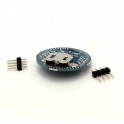WWVB NIST Radio Time Receiver (3V to 15V) Works with 3.3V & 5V
Always have accurate UTC time for your projects and Atomic Clocks. Use this receiver module to receive the 60kHz radio time in the United States. Ferrite antenna included. Comes soldered or as a kit. Works with 3.3V, 5V, 12V etc. 3V to 15V DC.






















